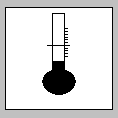| Chocolate, solid | [German version] |
Table of contents |
|
| General: | ||
| Product information | ||
| Packaging | ||
| Transport | ||
| Container transport | ||
| Cargo securing | ||
Product information
Product name
| German | Schokolade, fest (Tafelschokolade) |
| English | Chocolate (Slab chocolate) |
| French | Chocolat (Chocolat en tablettes) |
| Spanish | Chocolate (Tabletas de chocolate) |
| Scientific | |
| CN/HS number * | 1806 ff. |
(* EU Combined Nomenclature/Harmonized System)
Product description
Chocolate is a product of cocoa, made by mixing cocoa mass, cocoa butter and sugar (sucrose) using special machinery, with so-called conching (kneading) having a considerable influence on the quality of the chocolate. Conching reduces water content, improves texture and moderates the bitterness and aroma of the chocolate. In conching, the rolled mixture is refined by uninterrupted shearing to yield a homogeneous texture, with lecithin increasing the fluidity of the liquid chocolate.
Production of chocolate products:

Figure 1
The greater the cocoa content, the higher the quality of the chocolate. Thus, bitter chocolate, with a cocoa mass content of 60%, is the highest grade of chocolate.
| Chocolate type | Cocoa mass [%] |
Milk solids [%] |
Milk fat [%] |
Sugar [%] |
|---|---|---|---|---|
| Full-cream milk chocolate | 30 | 18 | 4.5 | < 47.5 |
| Sweetened dairy chocolate | 25 | 14 | 60 | |
| Bittersweet chocolate | 50 | < 50 | ||
| Bitter chocolate | 60 | < 40 | ||
| White chocolate | 20 | 14 | 3.5 | < 55 |
Quality / Duration of storage
Chocolate should have a glossy surface, which must be free of fat and sugar bloom, and a compact, homogeneous texture. Well conched chocolate forms a homogeneous mass with a smooth mouth feel and without graininess on the tongue. It breaks cleanly and must not crumble.
The chocolate must be free of pests.
Maximum duration of storage is as follows:
| Type | Temperature | Relative humidity | Maximum duration of storage | Source |
|---|---|---|---|---|
| Slab chocolate | 10 – 18% | 60 – 70% | 9 months | [1] |
| Filled chocolate, such as milk chocolate, sweetened dairy chocolate, nut and almond chocolate and fondant-filled chocolate |
10 – 18% | 60 – 70% | 3 – 5 months | [1] |
Old chocolate loses its good eating properties.
Intended use
Chocolate (in slabs) and chocolate products such as individual filled chocolates and hollow molded figures (e.g. Easter eggs, Father Christmases) are delicious, energy-rich products of the confectionery industry. Chocolate is also used for coating fresh patisserie products and long-life cakes and cookies (cooking and baking chocolate).
Countries of origin
This Table shows only a selection of the most important countries of origin and should not be thought of as exhaustive.
| Europe | Germany, Sweden, Switzerland, Netherlands, Great Britain, France |
| Africa | |
| Asia | Java, East Asia |
| America | Ecuador, Venezuela, USA |
| Australia |
Back to beginning
Packaging
Chocolate is mainly packaged in aluminum foil or composite films, paper or plastic trays and then packaged in batches in mill- and corrugated board cartons. To provide the cartons with greater stability, they are strapped with plastic or metal strapping. The packaging size of the cartons is so selected that the dimensions of the individual area modules or area module multiples are conformed to the conventional pallet sizes (800×1200 mm and 1000×1200 mm) and cargo units may thus be produced.
| Marking of packages | ||
 Keep dry |
 Top |
 Keep away from heat (solar radiation) |
Back to beginning
Transport
Symbols
 General cargo |
 Temperature-controlled |
Means of transport
Ship, truck, railroad, aircraft
Container transport
The basic problem with transporting chocolate in containers is its relatively low melting point. Solar radiation and other external influences (heat sources, such as double bottom tanks, engine rooms) may cause the temperature in the container to rise considerably and exceed the melting point, so making enormous quality degradation inevitable. Factors having a decisive influence on the selection of an appropriate container type are the season, the route, the duration of the voyage and the container stowage space on board. Standard containers do not offer any protection against external temperature fluctuations, as the external temperature is transmitted very quickly through the relatively thin walls into the inside of the container, in particular in the case of solar radiation. If chocolate is to be transported in containers, refrigerated containers (integral units or porthole containers) are therefore more suitable. Due to their insulated walls, these are less sensitive to external temperature fluctuations and the connected refrigeration units allow the required travel temperature to be maintained. However, problems may arise with this container type if the refrigeration units are not switched on and reliance is placed solely upon the higher level of insulation. Even with these containers, direct solar radiation for example may raise the internal temperature to a critical value. In general, it is essential to maintain the cold chain throughout transport.
Cargo handling
It is also imperative that the goods be protected from moisture (rain, snow) during cargo handling and from excessively low and high temperatures, as the packaging (paperboard cartons) is extremely sensitive to moisture and loses stability. Damp conditions may also reduce the quality of the chocolate itself, for example by causing sugar bloom, rancidity, mold and a musty odor.
Since the cargo is relatively sensitive to breakage, the packages must be handled with appropriate care.
Stowage factor
| 1.83 m3/t (millboard cartons) [1] | |
| 2.34 m3/t (boxes, cartons) [11] |
Stowage space requirements
Cool, dry. To provide protection against solar radiation, chocolate is best stowed below deck. It must under no circumstances be stored near heat sources (heated double bottom tanks, engine rooms), as its melting point is approx. 28°C.
Segregation
Marker pen/oil crayon (only)
Cargo securing
Because of its considerable impact- and pressure-sensitivity, packages of this cargo must be secured in such a way that they are prevented from damaging each other. Spaces between packages or pallets must be filled, to prevent slippage or tipping. By selecting the correct packaging size or cargo unit (area module or area module multiple), holds can be tightly loaded (without spaces).
Back to beginning
Risk factors and loss prevention
RF Temperature
Chocolate requires particular temperature, humidity/moisture and possibly ventilation conditions (SC VI) (storage climate conditions) .
| Designation | Temperature range | Source |
|---|---|---|
| Favorable travel temperature | 10 – 18°C | [1] |
| 4.4 – 7.2°C | [11] |
The optimum storage and transport temperatures are 10 – 18°C. At as low a temperature as 21°C, chocolate deteriorates with respect to both appearance and taste. At 24°C it becomes soft, and slabs, hollow molded figures (e.g. Easter eggs, Father Christmases) and individual filled chocolates become deformed, nuts turn rancid and cocoa butter becomes greasy on exposure to solar radiation.
28°C is the melting point: the fat constituents separate out and then solidify upon recooling, a fat bloom forming on the surface of the product, i.e. a gray to gray-blue coating of separated fat. This fat bloom is particularly common in the case of individual chocolates filled with marzipan, nougat and similar fatty fillings.
Chocolate is very susceptible to temperature fluctuations (sugar bloom formation). A sugar bloom forms when moisture is present, which dissolves the sugar in the chocolate. When the water evaporates, the sugar remains on the surface in the form of crystals.
Chocolate may be transported as a refrigerated cargo at 4.4 – 7.2°C; however, there is risk of condensation if refrigerated cargo is unloaded in a warm environment [11].
Confectionery with a liquid filling, such as liqueur chocolates, does not tolerate any frost, as the sugar crust inside cracks due to expansion of the liquid filling (thermal dilatation), so requiring particular care in the case of container transport during winter. Individual chocolates filled with soft fondant may also crack.
Back to beginning
RF Humidity/Moisture
Chocolate requires particular temperature, humidity/moisture and possibly ventilation conditions (SC VI) (storage climate conditions) .
| Designation | Humidity/water content | Source |
| Relative humidity | 65 – 70% | [1] |
| Water content | 0.5 – 1.6% | [1] |
| Maximum equilibrium moisture content | 70% | [1] |
Chocolate must be protected from all forms of moisture (seawater, rain and condensation water). Excessive humidity or marked temperature fluctuations cause sugar bloom: moisture dissolves the sugar, evaporation of the water causing the sugar to recrystallize in the form of fine crystals. High humidity levels and temperatures also turn chocolate musty, moldy and rancid.
Back to beginning
RF Ventilation
Chocolate requires particular temperature, humidity/moisture and possibly ventilation conditions (SC VI) (storage climate conditions).
If the product is at „shipping dryness“, i.e. the water content of the paperboard cartons is 5 – 8%, ventilation is not normally required.
However, if there is a risk of cargo sweat, which may result, for example, in wetting of the paperboard cartons and thus in a reduction in stability and strength and depreciation of the product itself, the following ventilation measure is recommended:
Recommended ventilation conditions: air exchange rate: 6 changes/hour (airing)
Back to beginning
RF Biotic activity
Chocolate displays 3rd order biotic activity.
Chocolate belongs to the class of products in which respiration processes are suspended, but in which biochemical, microbial and other decomposition processes still proceed.
Back to beginning
RF Gases
No risk.
Back to beginning
RF Self-heating / Spontaneous combustion
No risk.
Back to beginning
RF Odor
| Active behavior | Chocolate has a slight, pleasant odor. Moisture and high temperatures may cause the odor to turn musty. |
| Passive behavior | All cocoa products absorb foreign odors very easily and have therefore to be stored and transported under odor-free conditions. Unsuitable packaging materials may result in an unpleasant off-flavor. The higher is the cocoa butter content, the more sensitive are the products, as cocoa butter absorbs and retains foreign aroma substances. |
Back to beginning
RF Contamination
| Active behavior | Chocolate does not cause contamination. |
| Passive behavior | Chocolate is extremely sensitive to contamination. It must be protected from dust, dirt, fats and oils. |
Back to beginning
RF Mechanical influences
Packages should be handled with appropriate care, as high stresses may lead to damage to carton walls and edges. The chocolate itself is likewise relatively sensitive to breakage.
The packages must be secured appropriately in the hold or container so that they cannot move during transport. In the case of container transport, it is also important for the goods to be secured in the door area so that they cannot fall out of the container when the doors are opened.
Back to beginning
RF Toxicity / Hazards to health
No risk.
Back to beginning
RF Shrinkage / Shortage / Theft
There is a high risk of theft, therefore in the case of container transport stow containers such that the doors of adjacent containers block each other, thereby preventing access to the container interior. In the event of conventional shipment, stow in lockers.
Back to beginning
RF Insect infestation / Diseases
Cocoa moths (also known in the US as almond moths) and meal moths may attack chocolate. Nut chocolate may also suffer attack from flour beetles and dried fruit moths. Occasionally, maggots are found in chocolate, particularly if it contains nuts or fruit.
Back to beginning
